Lichfield Cathedral
| Lichfield Cathedral | |
|---|---|
| Cathedral Church of the Blessed Virgin Mary and St Chad | |
 The West Front of Lichfield Cathedral | |
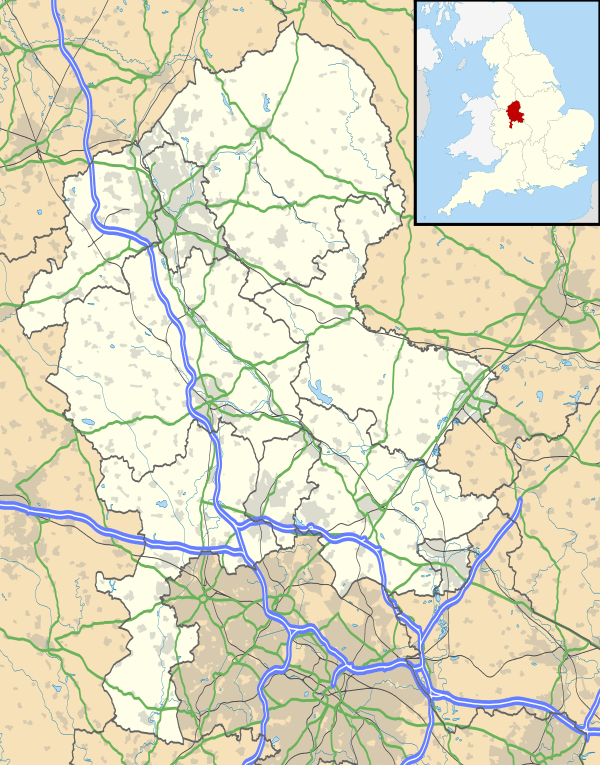 Lichfield Cathedral Shown within Staffordshire | |
| 52°41′08″N 1°49′50″W / 52.685556°N 1.830556°WCoordinates: 52°41′08″N 1°49′50″W / 52.685556°N 1.830556°W | |
| Location | Lichfield, Staffordshire |
| Country | England |
| Denomination | Church of England |
| Previous denomination | Roman Catholic |
| Website | www.lichfield-cathedral.org |
| Architecture | |
| Status | Active |
| Functional status | Cathedral |
| Style | Gothic |
| Years built | c. 1195–1340 |
| Specifications | |
| Length | 113m |
| Nave width | 21m |
| Width across transepts | 50m |
| Height | 76.8 m (central spire) |
| Number of towers | 3 |
| Number of spires | 3 |
| Spire height | 76.8 m (crossing), 60.5 m (western) |
| Administration | |
| Diocese | Lichfield (since 787-1075, c.1200-) |
| Province | Canterbury |
| Clergy | |
| Bishop(s) | Jonathan Gledhill |
| Dean | Adrian Dorber |
| Laity | |
| Director of music | Ben and Cathy Lamb |
| Organist(s) | Martyn Rawles |
Lichfield Cathedral is situated in Lichfield, Staffordshire, England. It is the only medieval English cathedral with three spires. The Diocese of Lichfield covers all of Staffordshire, much of Shropshire and part of the Black Country and West Midlands. The 99th and current Bishop of Lichfield is the Right Rev Michael Ipgrave who was appointed on 10 June 2016.
Overview
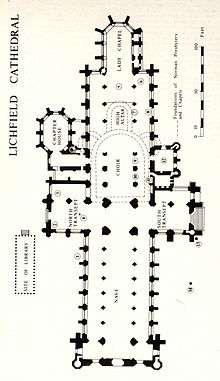
The cathedral is dedicated to St Chad and Saint Mary. Its internal length is 113 metres (370 feet), and the breadth of the nave is 21m (68'). The central spire is 77m (252') high and the western spires are about 58m (190').
The stone is sandstone and came from a quarry on the south side of Lichfield. The walls of the nave lean outwards slightly, due to the weight of stone used in the ceiling vaulting; some 200–300 tons of which was removed during renovation work to prevent the walls leaning further.
Lichfield suffered severe damage during the English Civil War in which all of the stained glass was destroyed. In spite of this the windows of the Lady Chapel contain some of the finest medieval Flemish painted glass in existence. Dating from the 1530s it came from the Abbey of Herkenrode in Belgium, in 1801, having been purchased by Brooke Boothby when that abbey was dissolved during the Napoleonic Wars. It was sold on to the cathedral for the same price. There are also some fine windows by Betton and Evans (1819), and many fine late 19th century windows, particularly those by Charles Eamer Kempe.
The Lichfield Gospels, also known as the Book of Chad, are the gospels of Matthew and Mark, and the early part of Luke, written mainly in Latin with some text in early Welsh and dating from around 730. There were originally two volumes but one went missing around the time of the English Civil War. It is closely related in style to the Lindisfarne Gospels. The manuscript is on display in the Chapter House from Easter to Christmas.
The Close is one of the most complete in the country and includes a medieval courtyard which once housed the men of the choir. The three spires are often referred to as 'the Ladies of the Vale'.
History of the cathedral
Early history and elevation to Archbishopric

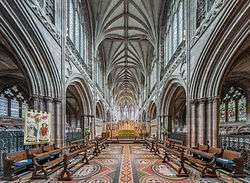
When Chad was made Bishop of Mercia in 669 he moved his See from Repton to Lichfield, possibly because this was already a holy site, as the scene of martyrdoms during the Roman period. The first cathedral to be built on the present site was in 700AD when Bishop Hedda built a new church to house the bones of St Chad which had become a sacred shrine to many pilgrims when he died in 672. Offa, King of Mercia seemed to resent his own bishops paying allegiance to the Archbishop of Canterbury in Kent who, whilst under Offa's control, was not of his own kingdom of Mercia. Offa therefore created his own archbishopric in Lichfield, who presided over all the bishops from the Humber to the Thames. All this began in 786, with the consent of Pope Adrian. The Pope’s official representatives were received warmly by Offa and were present at the Council of Chelsea (787), often called `the contentious synod', where it was proposed that the Archbishopric of Canterbury be restricted in order to make way for Offa's new archbishop. It was vehemently opposed, but Offa and the papal representatives defeated Archbishop Jaenbert, installing Higbert as the new Archbishop of Lichfield. Pope Adrian sent Higbert the pallium, denoting his support for this move. In gratitude, Offa promised to send an annual shipment of gold to the pope for alms and supplying the lights in St. Peter's church in Rome. However, The Archbishopric of Lichfield lasted for only 16 years, ending soon after Offa's death, when it was restored to Archbishop Aethelheard of Canterbury.
Starting in 1085 and continuing through the twelfth century the original wooden Saxon church was replaced by a Norman cathedral made from stone, and this was in turn replaced by the present Gothic cathedral begun in 1195. It was completed by the building of the Lady Chapel in the 1330s. The Choir dates from 1200, the Transepts from 1220 to 1240 and the Nave was started in 1260. The octagonal Chapter House, which was completed in 1249 and is one of the most beautiful parts of the Cathedral with some charming stone carvings, houses an exhibition of the cathedral's greatest treasure, the Lichfield Gospels, an 8th-century illuminated manuscript.
Devastation of the English Civil War
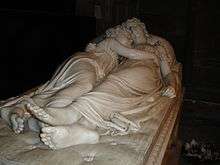
There were three great sieges of Lichfield during the period 1643–1646 as the cathedral was surrounded by a ditch and defensive walls it made a natural fortress. The cathedral authorities with a certain following were for the king, but the townsfolk generally sided with the parliament, and this led to the fortification of the close in 1643. Robert Greville, 2nd Baron Brooke, led an assault against it, but was killed by a deflected bullet from John Dyott (known as 'dumb' because he was a deaf mute) who along with his brother Richard Dyott had taken up a position on the battlements of the central cathedral spire on 2 March 1643. Brooke's deputy Sir John Gell, took over the siege. Although the Royalist garrison surrendered to Gell two days later, the close yielded and was retaken by Prince Rupert of the Rhine on 20 April of the same year.
Rupert's engineers detonated the first mine to be used in England to breach the defences. Unable to defend the breach, the parliamentarians surrendered to Rupert the following day. The cathedral suffered extensive damage: the central spire was demolished, the roofs ruined and all the stained glass smashed. Bishop Hacket began the restoration of the cathedral in the 1660s, aided by substantial funds donated by the restored monarch, but it was not until the 19th century that the damage caused by the Civil War was fully repaired. Up until the 19th century, on top of an ornamented gable, between the two spires, stood a colossal figure of Charles II, by Sir William Wilson. Today it stands just outside the south doors.
Victorian restoration
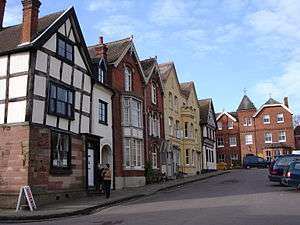
Although the 18th century was a golden age for the City of Lichfield, it was a period of decay for the cathedral. The 15th-century library, on the north side of the nave, was pulled down and the books moved to their present location above the Chapter House. Most of the statues on the west front were removed and the stonework covered with Roman cement. At the end of the century James Wyatt organised some major structural work, removing the High Altar to make one worship area of Choir and Lady Chapel and adding a massive stone screen at the entrance to the Choir. Francis Eginton painted the east window and was commissioned by the chapter to do other work in the cathedral. The ornate west front was extensively renovated in the Victorian era by Sir George Gilbert Scott.

It includes a remarkable number of ornate carved figures of kings, queens and saints, working with original materials where possible and creating fine new imitations and additions when the originals were not available. Wyatt's choir-screen had utilised medieval stone-work which Scott in turn used to create the clergy's seats in the sanctuary. The new metal screen by Francis Skidmore and John Birnie Philip to designs by Scott himself is a triumph of High Victorian art, as are the fine Mintons tiles in the choir, inspired by the medieval ones found in the Choir foundations and still seen in the Library.
Lichfield Angel
In February 2003, an eighth century sculpted panel of the Archangel Gabriel was discovered under the nave of the cathedral. The 600mm tall panel is carved from limestone, and originally was part of a stone chest, which is thought to have contained the relics of St Chad.[1] The panel was broken into three parts but was still otherwise intact and had traces of red pigment from the period. The pigments on the Lichfield Angel correspond closely to those of the Lichfield Gospels which have been dated to around 730AD. The Angel was first unveiled to the public in 2006, when visitor numbers to the cathedral trebled. After being taken to Birmingham for eighteen months for examination, it is now exhibited in the cathedral.
Dean and Chapter
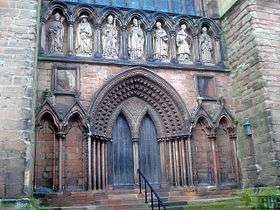
- Dean – The Very Revd Adrian Dorber[2] (since 24 September 2005 installation)[3]
- Canon Precentor – The Revd Canon Wealands Bell (since 22 September 2007 installation)[3]
- Canon Chancellor – The Revd Canon Dr Anthony Moore (since 19 January 2013 installation)[3]
- Archdeacon of Lichfield, Canon Treasurer & Acting Custos – The Ven Chris Liley (since 3 March 2001 installation)[3]
Lay Chapter
- Bryan Ramsell
- Anne Parkhill
- Margaret Harding
- Peter Durrant
Music
Organists
Notable organists of Lichfield Cathedral include the 17th-century composer Michael East, and the musical educator and choral conductor William Henry Harris who conducted at the coronations of both Elizabeth II and George VI
Priest Vicars Choral
- The Precentor's Vicar: Vacant
- The Dean's Vicar: Vacant
- The Chancellor's Vicar: Vacant
- The Treasurer's Vicar: Vacant
Lay Vicars Choral and Choristers
The Choir has 9 Lay Vicars Choral and up to 18 Choristers.[4]
Burials
- Chad of Mercia, Bishop of the Northumbrians, later Bishop of the Mercians and Lindsey People, and Saint – originally buried in the Church of Saint Mary which became part of the cathedral
- Geoffrey de Muschamp, Bishop of Coventry (1198–1208)
- William de Cornhill, Bishop of Coventry (1214–1223)
- Alexander de Stavenby, Bishop of Coventry and Lichfield (1224–1238)
- Hugh de Pateshull, Bishop of Coventry and Lichfield (1239–1241)
- Roger Weseham, Bishop of Coventry and Lichfield (1245–1256)
- Walter Langton, Lord High Treasurer of England and Bishop of Coventry and Lichfield (1296–1321)
- Henry Paget, 1st Marquess of Anglesey, KG, GCB, GCH, PC (1768- 1854), cavalry officer during the Battle of Waterloo.[5]
- George Augustus Selwyn, Bishop of Lichfield (1868–1878), first Anglican Bishop of New Zealand (1841–1858) and Primate of New Zealand (1858–1868)
See also
| Wikimedia Commons has media related to Lichfield Cathedral. |
- Architecture of the medieval cathedrals of England
- Bishops of Lichfield
- English Gothic architecture
- Lichfield Cathedral School
- List of cathedrals in the United Kingdom
- List of Grade I listed buildings in Staffordshire
- Grade I listed churches in Staffordshire
- List of the Bishops of the Diocese of Lichfield and its precursor offices
- Mercian Trail
References
- ↑ Wilcox, Peter (2011). The Gold, the Angel and the Gospel Book. Lichfield Cathedral. pp. 16–17. ISBN 978-0-9558887-7-9.
- ↑ "Who's Who". Lichfield-cathedral.org. 28 January 2011. Retrieved 20 January 2012.
- 1 2 3 4 Lichfield Cathedral – Who's Who
- ↑ Lichfield Cathedral Choir Web Site
- ↑ Lord Anglesey's burial - See p. 35
External links
- Lichfield Cathedral Web Site
- Manuscripts of Lichfield Cathedral - Digital facsimiles of the St Chad Gospels and Cathedral's Wycliffe New Testament; includes multispectral images and presently sixteen interactive 3D renderings; College of Arts & Sciences, University of Kentucky